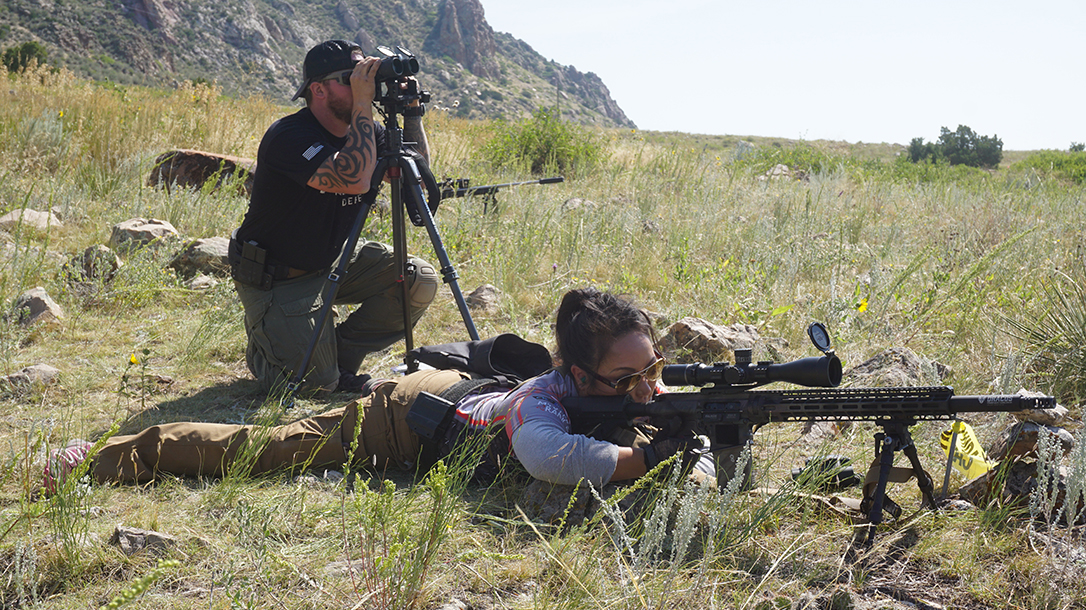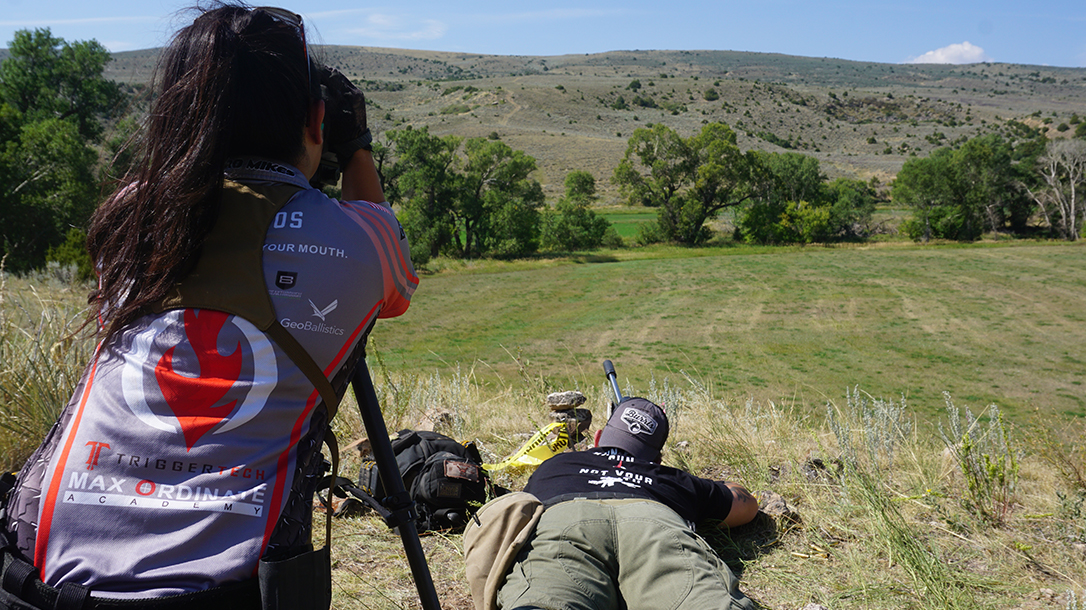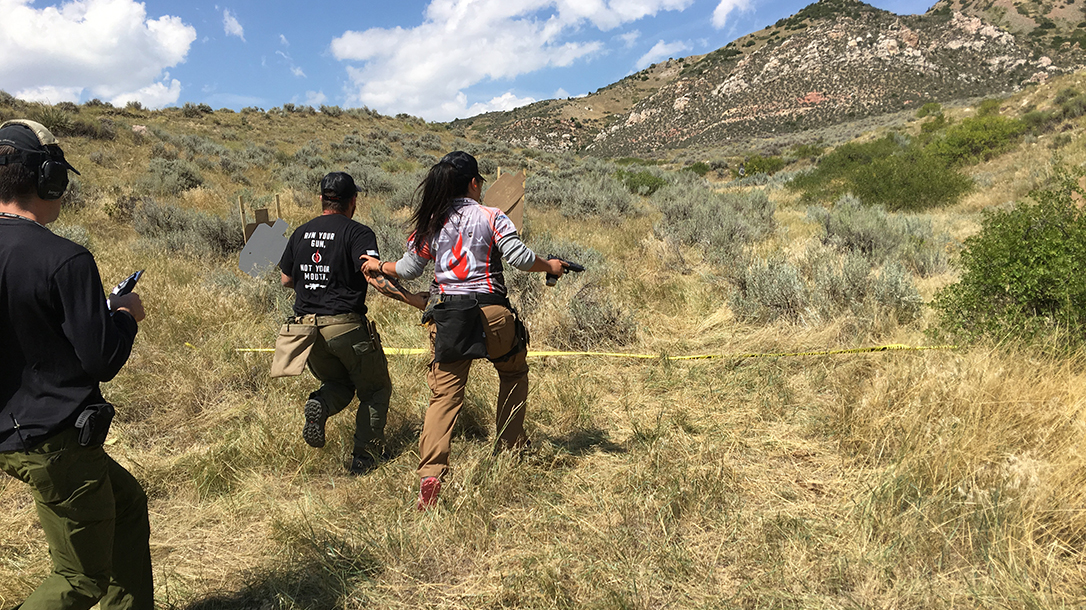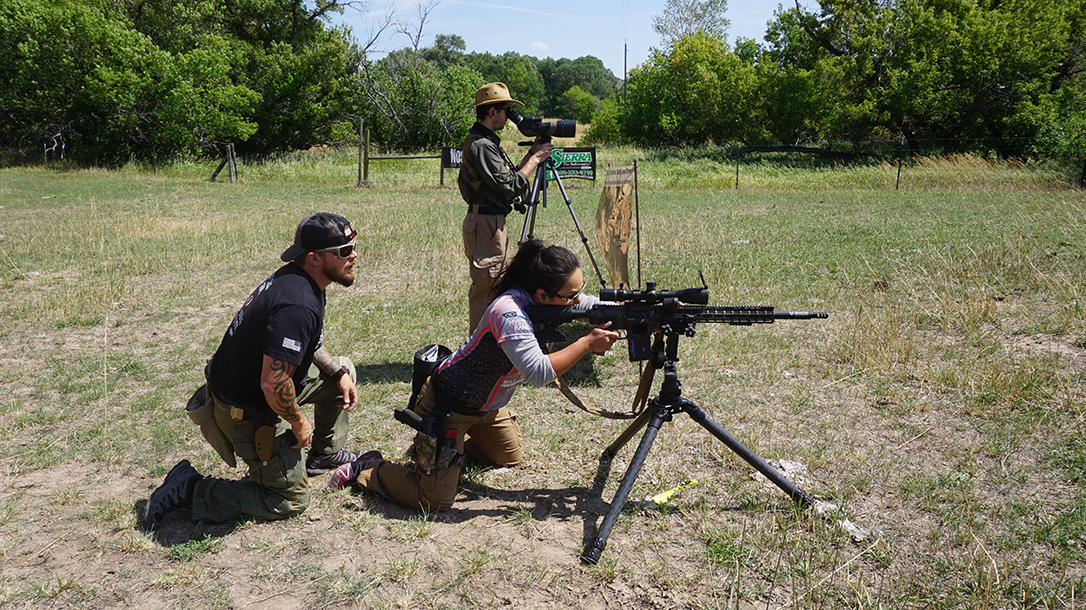Many competitions within the shooting industry rely on both individual skill and equipment. Will your caliber choice be competitive? Does your scope track? Is your ammo accurate? All of these factors play a part, and I haven’t even finished the list. Now let me throw you a curve ball. Recently, I competed in the Burris Optics Team Challenge by Competition Dynamics. Yes, you read that right. Team Challenge.
On top of all the individual preparations, now I had to worry about another person. In this case, it wasn’t so much physical capability but communicating effectively.
Advertisement — Continue Reading Below
Match Rules
The Burris Optics Team Challenge was held in Douglas, Wyo. The match takes place on a massive ranch located just outside the town’s limits. The scenery was amazing yet intimidating—rolling hills and gradual inclines mixed with mountainous terrain. Over three days, two-person teams would complete one field course of fire plus two assault stages per day.
Each team had a designated long-gun shooter and carbine shooter. The rules for each are simple: The carbine shooter must shoot first at each stage, engaging 50 percent of the targets with no limit on the number rounds fired to achieve impacts, while the long-gun shooter is limited to one round per target and is required to engage every target. If you do not engage a target, there is a time penalty.
Advertisement — Continue Reading Below
With targets ranging from 200 to 1,200 yards on the field courses, you and your teammate have one hour to complete the assigned field course. Teams are released on their assigned course in intervals of 20 minutes. The field course itself spans between 1.2 and 1.5 miles long, with four shooting positions scattered intermittently along the trail.
Some shooting positions may have four targets but require the long-gun shooter to shoot from two positions. Some only require one shooting position with eight targets.
If you aren’t grinning from ear to ear reading about this challenge, here’s where I drop the bomb: There are no obvious targets. They are hidden in shadows and terrain. They are rusty and haven’t seen paint since they left the AA Targets facility countless years ago. Did you bring some good binoculars? Do you have enough clarity, magnification and field of view? How about your rangefinder? Is it accurate?
Advertisement — Continue Reading Below
Let’s review: Both you and your partner need to have smart gear and effective communication, as you have a set amount time to locate, range and engage targets. Ultimately, your pace is dictated by you and your partner. Some teams ran. Others walked.
Upon arriving at a shooting position, there is a spotter/range officer (RO) who will call out impacts for your team. There is no set limit for how long you can remain at each stage, but this is no time to slouch: You receive bonus points for every minute you finish under an hour. Every competition needs penalties, right? If a team behind you catches up at a position or on the road, they take priority, and you must wait to finish the stage or move on to your remaining position.
The assault stages are held on day one and two of the match, after you complete the daily field course. Two assault stages per day. These are primarily a combination of the long gunner shooting their pistol in a USPSA scoring format and the carbine gunner running and gunning similar to a 3-Gun-style match.
Advertisement — Continue Reading Below
This competition is a literal and figurative blast. Over the course of three days, you and your partner will have ups and downs. Ultimately, it will be an experience you will talk about together until the following year.
A Significant Step
Now onto my story: I chose my significant other. Yep. Not only did I want to compete in a match fraught with the challenges of working with a partner, but I also decided to compete with my fiancé, Rei Hoang.
Advertisement — Continue Reading Below
Rei and I have been together a few years now. Our relationship was practically founded on long-range shooting. I was a U.S. Marine scout sniper teaching law enforcement and private courses. She took one of my courses and has been a sponge ever since. She takes it all in and continuously seeks to get better, learning more and identifying her deficiencies so she can address them. It took patience on my side to keep it paced so she wasn’t just learning “tips, tricks, and tacti-cool methods” but solidifying her fundamentals.
That said, her skills weren’t a concern to me in regard to this match. My concerns were our ability to communicate, keeping any frustration at a minimum and, most importantly, having fun. Sure, I wanted to win—everything I do is centered around winning. But at the end of the day, I could not allow my desire to win suck all of the fun out of this adventure we were going to take on together. So, we began planning. With my work schedule and her school schedule, practicing together in an environment that emulated the competition wasn’t possible. We’d essentially be going in blind.
Advertisement — Continue Reading Below
But that didn’t mean we wouldn’t draw from my past experiences and tailor our plan to play to our strengths and minimize our weaknesses to finish each field course early. I would work as the long-gun shooter, and Rei would handle the carbine. To tailor our plan to our strengths, we first needed to understand the weak areas. Her physical fitness was not up to my level. So, to maximize speed, we would lighten her load to the absolute minimum: rifle and ammo.
While moving from stage to stage, I would run ahead as fast as I was capable, carrying all of our team gear. Upon arrival at the shooting position, I would locate and range as many targets as I could prior to her arrival.
Once there, she would immediately get into position while I would point out targets and feed her the ranges with holds. The match director stated that we needed to be within arm’s distance of one another before we could engage targets at a shooting position. Our method worked perfectly while not violating this rule.
Advertisement — Continue Reading Below
Finally, while I engaged my required targets, she would repack all of our gear. This allowed us to finish the stage and move quickly to our next designated position. Sounds peachy so far, right? Believe me, we had a great time competing together, but it had its challenges. As I write this, I can’t help but laugh at those memorable moments.
Trouble In Paradise
Rei was sitting behind me, an arm’s length away, feeling good about having already engaged her targets. I asked her what her wind call was for a specific target. Mind you, we were shooting similar calibers—the 6mm Creedmoor for her and the 6mm XC for me. She told me what she held. Looking through my scope with an H59 reticle, I held right of the target 0.5 mils like she said. The conditions from when she shot felt similar. Focusing on the reticle, I exhaled to my natural respiratory pause and applied pressure to the trigger. Bang! I began my follow-through and attempted to observe the impact and hear the sweet sound of the projectile impacting the target.
Advertisement — Continue Reading Below
But there was no sweet sound, no impact. Just a dust cloud that appeared to impact 0.5 mils right of center. Did I mention that I am also a perfectionist?
“Rei, where did that hit?”
“I don’t know. I wasn’t watching.” She replied.
At this point, my mind drifted from engaging targets to how long this hour would feel.
“You are a horrible partner!” I yelled.
She giggled and said, “Sorry, babe. I thought you were better than that and didn’t need a spotter.”
Oh, yes she did. But at this point, I had to stay focused on the task at hand—engaging targets, dialing my DOPE, making wind calls—all while thinking about giving her a piece of my mind while we made our way to the next position. Thankfully, my correction was spot on, and I didn’t miss another shot.
I finished up, cleared my rifle and yelled to Rei, “Pack my shit up! Get us ready to leave!”
All I heard was, “Yes, sir.”
I took off running to get back to my gear and there it was, all packed up, ready for me to grab and go. Rei was already walking at a fast pace towards the next position a half-mile down the road. How could I possibly be mad at her now?
Our communication evolved over the remainder of that course. I would tell her when I wanted her to spot. We would discuss wind calls more in depth. It only took one stage to work out the kinks, and I was extremely happy about that. Little did I know that the assault stages would induce more friction.
The Assault Stage
Fast-forward three hours to the beginning of the assault stage. The RO read the stage description: “The rifle-shooter will need their rifle and pistol. Bring as much ammo as you think you will need. The carbine shooter will only need their carbine.”
The RO continued: “The stage will start with the rifle shooter’s pistol loaded at the ready, rifle slung. The carbine shooter will not load until the pistol shooter has engaged or passed all of their designated targets. Once given the OK, the carbine shooter will load and engage all carbine targets. At the end of the run, the carbine shooter will unload and show clear. The rifle shooter will load and engage unknown-distance target with two impacts required to stop time. All targets are cardboard IPSC targets. You must have one A-zone hit, two B- or C-zone hits, or four D-zone hits for a target to be considered neutralized.”
Perfect! In my mind, I was already imagining how easy this would be for us. We were also randomly selected to go first. Showtime!
Standing in a dry, narrow creek bed, my rifle slung across my back and my pistol holstered waiting for the order to load, my excitement was eating away at me. At this point, I was wondering what the hell was taking the RO so long to give me the command to load and make ready.
I looked back to find myself alone with the RO, no Rei in sight.
“Rei! What the hell are you doing?”
In the sweetest voice you can imagine, she replied, “I’m taking off my bipod. Need to save weight.”
I couldn’t believe it. “Seriously?” I asked. We were using carbon-fiber Modular Evolution bipods. Carbon. Fiber.
But finally, she was ready. She stood behind me with her rifle slung across her chest. The buzzer went off, and like a mad man I started moving down the creek bed, scanning left and right. As targets appeared, I raised my pistol, got on target, pulled the trigger. A mixture of steel and cardboard targets were placed at random, some causing me to think while others got a reactionary shot. This continued for approximately 50 yards. If you ask Rei, she would tell you a mile. (In defense, the density altitude was upwards of 8,000 feet.) Upon reaching the end of the pistol zone, I cleared my gun and reholstered it.
Rei’s Turn
I frantically moved behind Rei for her to load and start dropping targets. But standing behind her, I noticed she was already out of breath and performing a chicken-wing-style loading procedure. “Let’s go, Rei! Move it, woman!”
At first, things seemed normal—slow, but normal. We would move down the creek bed. A target appears, Rei engages. Life was good, and then she ran out of gas. The rifle was becoming heavier and heavier with every step and every shot. Trying not to panic, I switched to observer mode, telling her to hit targets again if they weren’t neutralized. Target over there. Look left: target. Don’t shoot the hostage. All phrases encouragingly directed at Rei as I attempted to salvage our score.
We get 100 yards or so into the creek bed and I can’t help but say with a grin, “I thought you were going to get in shape Rei? What happened with that?”
We get to the end of the creek bed. Two targets are to the left 15 yards away, partially covered to signify hostages. At this point, Rei is gassed. Her brain has reverted back to basic motor skill functions. See target, shoot target. She was standing there, breathing heavily and attempting to shoulder her rifle, when I chimed in: “Oh no you don’t, girl! See that rock! Right there! In front of you! Put your rifle on there and don’t shoot the hostages!” I said this because she had already killed two hostages 20 yards back. Bang! Bang! Her evolution was complete.
She was so relieved—and once again not thinking. Immediately, I yelled, “Rei! Unload and show clear!”
She replied with a gasping “OK.”
Knowing that I still had an unknown-distance target to engage with my rifle, I quickly grabbed her gun, unloaded and showed the RO that it was clear. Rei, still trying to fully catch her breath, stepped back and allowed me to complete the stage.
The timer stopped. I cleared the gun, and now we could see what the damage was. The RO said, “Great job, guys! Let’s go count hit targets.” I’ve never had much of a filter, so I said, “Yeah, Rei, let’s go count how many hostages you smoked!” I waited for some witty reply or even a threat from Rei, but her attempt to catch her breath was limiting her ability to speak.
As you can see, it takes a strong relationship to endure the stress of competing as a team. Understanding shortcomings and working to overcome them is a huge part of our success. We ended up finishing eighth overall out of 30 teams. Our focus was to go as hard as we could, improving our plan each day based on what we learned from each other. Most importantly, we never lost sight of having fun together.
Burris Optics Team Challenge Gear
You don’t need the best equipment right out of the gate to get into precision rifle shooting. Obtain an accurate rifle with a quality scope that tracks properly. Look for the reticle measurements to match your turret’s adjustments. If your reticle is in mils, make sure your scope’s dials adjust in mils.
You’ll also need a sturdy bipod for your rifle and a rear bag. Select a caliber that will help you achieve your goals. Having the ability to purchase ammo easily is another good start.
And finally, take a precision long-range course early on so you learn proper fundamentals.
Here’s some of the gear Tyler and I used at the Team Challenge. —Rei Hoang
TYLER’S RIFLE:
- American Rifle Company Mausingfield action
- Bartlein 6mm barrel
- Grayboe stock
- TriggerTech Rem 700 Diamond Trigger
- KMW Bottom Metal
Accessories:
- Modular Evolution Bipod
- Nightforce 4-16x42mm ATACR scope with H59 reticle
- Spuhr scope mount
- Sand Sock Gear rear bag
- Mystery Ranch 3-Day Attack Pack
- HOG Saddle
- Bushnell Fusion 1-Mile ARC binoculars
- Copper Creek ammo
REI’S RIFLE:
- Falkor Defense Omega
- Dracos 6mm Creedmoor Barrel
- TriggerTech Adaptable AR Primary Trigger
Accessories:
- Modular Evolution Bipod
- Burris 4-20x50mm XTR II scope with H59 reticle
- Sand Sock Gear rear bag
- Steiner M830 binoculars
- Hornady ammo
This article is from the 2018 issue of Ballistic Precision. To subscribe or purchase individual copies, please visit OutdoorGroupStore.com.





























